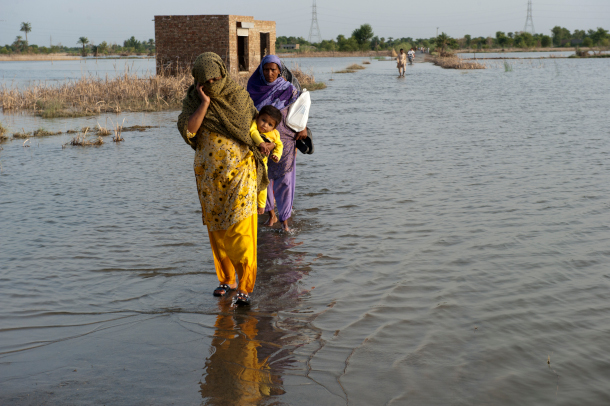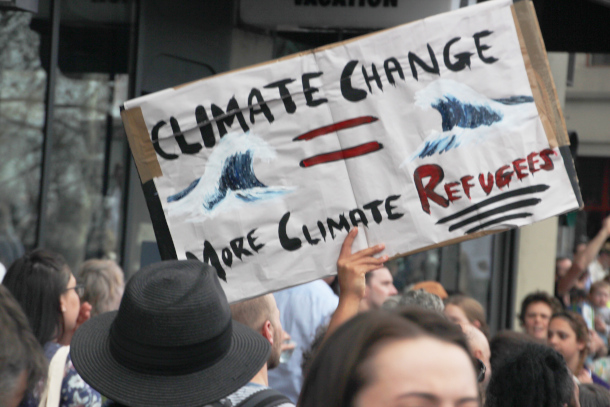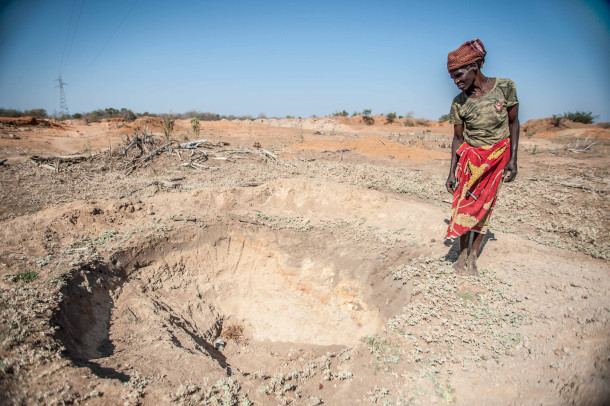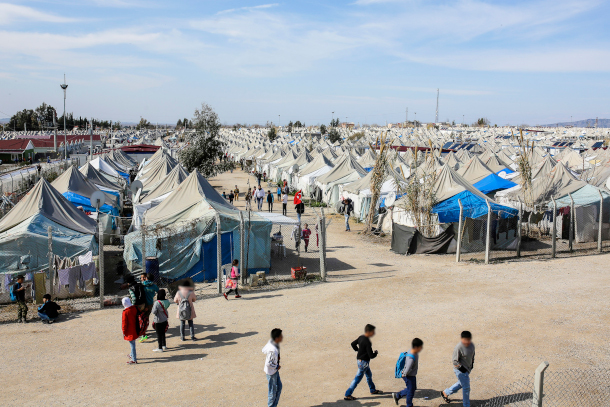Aid and Empathy for Climate Refugees
Air Date: Week of March 18, 2022

A family crosses flooded streets in Pakistan. According to the World Bank climate change could displace more than 200 million people by 2050. (Photo: Asian Development Bank, Flickr, CC BY ND NC 2.0)
Millions of white Ukrainian refugees have been welcomed by neighboring countries, while many black and brown refugees from the Global South are routinely turned away. Climate change is expected to displace as many as 200 million people, many of them people of color, by the year 2050. Kayly Ober, Program Manager for the Climate Displacement Program at Refugees International, joins Host Bobby Bascomb to talk about the intersections between the refugee crisis, racism, and climate change.
Transcript
BASCOMB: It’s Living on Earth, I’m Bobby Bascomb.
A report from the World Bank finds that if we continue our current trajectory for climate change, some 200 million climate refugees could be displaced worldwide by the year 2050. That’s around 100 times the roughly two and a half million Ukrainians who’ve fled their homes to escape Russian bombing. Neighboring countries have mobilized to welcome Ukrainians, offering safety and protection but many refugees from other countries have not been as warmly received. Worldwide, more than 82 million refugees have been forcibly displaced from their homes, and the vast majority of them are people of color. Syria, for example is facing one of the world’s largest refugee crisis, more than 12 million people have been displaced, some of them reportedly forced to choose between selling a kidney and selling a child to get by in extreme poverty. Yet, resources from the Global North do not flow to the Global South in a way that is commensurate with need. Kayly Ober, with Refugees International, says that lack of support is rooted in racism, something the international community needs to address as climate change exacerbates the refugee crisis in the coming decades. She points to the stark contrast in the reception that refugees of color have received compared to the warm welcome for Ukrainians.
OBER: We can see outright that although neighboring countries like Poland, and other EU countries have made exceptions for Ukrainians crossing into their borders, offered them protection, offered them the means and ability to live and work in those countries with open arms. You know, different types of refugees crossing, even in the midst of Ukraine conflict, like Africans living in Ukraine haven't received the same sorts of extended sort of protection. But more broadly, there are refugee crises all over the world. And a lot of those refugee crisis are in countries that are not white, right. And the way in which the world has responded has definitely not been as united as swift or emphatic as it has to the Ukrainian crisis. And this is in a variety of ways, first and foremost of offering protection. So we saw in the midst of the Syrian refugee crisis, as you noted, probably at its peak in 2015, 2016, millions of Syrians trying to get to the EU to seek out safety and protection. And being pushed back in many instances, being put in very precarious situations and they still are, right. So on the very same borders that are accepting Ukrainians with open arms, those same refugees are languishing at the borders and being pushed back because of the very racist nature of immigration policies in these countries. So you can't disentangle the way in which these countries are offering support from the racist underpinnings with which they offer it.
BASCOMB: Well, what are some of the ways in which war and environmental crises can overlap to create, you know, additional hardships for refugees, if any, at all?
OBER: Well, in a number of ways, so first, my colleagues at the UN Refugee Agency, UNHCR has done a variety of studies, which shows that 90% of those in fragile affected states that are currently in the midst of displacement are highly vulnerable to climate change and its effects. So you're talking about the way in which UNHCR views this is these are already highly fragile conflict affected states. You already have perhaps IDPs internally displaced people in camps, or at the margins of different cities or society in which they're not able to be in situations of resilience, because of the way in which the country is being affected by conflict and violence. And if you layer climate change on top of that, it further sort of destabilizes the ability to be resilient to these different forms of shocks. And so there's often an overlapping set of factors when it comes to sort of people who are facing displacement crises or are on the brink of facing displacement crises, including conflict and climate change.

A sign reads “climate change = more climate refugees” at a Global climate strike in Melbourne Australia on September 20, 2019. (Photo: John Englart, Flickr, CC BY SA 2.0)
BASCOMB: Well, how can we accommodate all of those people? I mean, the reason they're moving is untenable to live where they are but you know, the world's not producing any more resources. If the livable part of our planet becomes smaller and smaller how do we square that circle?
OBER: Well, the first thing I should say the difference between climate related displacement, and conflict related displacement is that we have the luxury of planning. We can pinpoint hotspots, we understand the ways in which, you know, climate change may play out on the ground. And so we really can figure out different sorts of vulnerabilities or risks we need to mitigate in order to allow people to stay in places where they're from first and foremost. So that's what we should be doing. And that's what the Groundswell report kind of digs into, which is, we need to mitigate carbon emissions drastically and immediately and that would actually hedge the effects of climate change dramatically. So anywhere from 50% to 80%, of the number of people that project will be moving by 2050 could be cut, if we do so. So it's clear that policymakers have a window of opportunity to act. And so I think that's the first thing we need to understand is we can mitigate carbon emissions but also we can invest in things that are, you know, low hanging fruit that are no brainers a win win. Things like climate change adaptation so folks can have more access to climate resistant crops, better forms of irrigation technology. I think that's something that we can do to sort of mitigate the effects of climate change to ensure that people can stay at home if they would like to. Now on the flip side, we have to acknowledge that even with the greatest amount of inputs related to these sorts of measures, people will still need to move, like you said. Some places will just be uninhabitable, especially if we don't mitigate carbon emissions and we have a rapidly closing window to do so. So I think policymakers need to acknowledge this reality and understand that people may be moving to cities within their own countries, but they often can or might cross borders. And so how do we ensure that that movement is safe, that people do not put their lives at risk and they're able to come to places that would offer them a quality of life and living that is dignified, right. So I think that's really where most tensions lie.
BASCOMB: Well, what kinds of protections does the United Nations currently provide for climate refugees? Especially compared to refugees from conflict or persecution.

Adelaide Maphangane stands beside an empty water hole in the district of Mabalane, Mozambique. Many people come to this area to dig for water and often leave empty handed. According to the International Federation of Red Cross, the holes they are digging to reach water are getting deeper by the day. (Photo: Aurélie Marrier d'Unienville , IFRC, Flickr, CC BY NC ND 2.0)
OBER: So I think what most of us think of when we think of refugees is the quintessential sort of UN Refugee Convention that was put together in 1951. So this was post World War II, the world came together and said- we cannot let this happen again. However, what they put together was by Europeans for Europeans, right. So it's a very narrow set of issues that are included within that convention. So it's based on persecution on five sacred grounds. So something like political affiliation, race, ethnic group, religion. So it's very narrow. And nowhere in the scope of that convention does it say anything about climate change, or environmental change or disaster, right. So there's, there's this kind of gap there when it comes to international protection. So if you were to say, be moving across the border, and applying for refugee status or asylum and you were to cite climate change a factor that would not be sufficient to grant you that status. And so that's where sort of the the problem lies right now.
BASCOMB: Well, to your knowledge is there any plan to change that? I mean, the problem of climate change is here and it's only going to get worse, right? I mean, we're looking at a lot of people potentially displaced in the future. What plans, if any, are there for the United Nations to address that, you know, gaping hole here?
OBER: So the Refugee Convention is sacrosanct, and the UN Refugee Agency, UNHCR, their mandate is underpinned by this by this convention. So there's no sort of effort to change the convention. However, there's been a new efforts to sort of expand interpretations of persecution under the umbrella of this convention. So for example, could you say that, you know, in the face of climate change, say there's a devastating flood that hits your village and washes away your home and washes away the village, you ask the government to help you and the government purposely does not offer you aid and support because you're a particular social group. Do you then qualify for refugee status based on the grounds of persecution in the context of climate change, right? And I think UNHCR has just put out some legal considerations around this that essentially say- yes, you know, maybe you do qualify for persecution in this sort of instance. And can we test through sort of case law how to really push the boundaries of this existing convention? Because really, one, it's sacrosanct but, two, if we were to renegotiate that within the UN, we might come up with something that's not as strong in today's sort of anti immigrant world, right. So they really want to push the boundaries now. It's the first time ever they've really said something of that nature. And so that's really I think the direction we'll be going in.
BASCOMB: And what is the Biden administration proposing in terms of the refugee crisis and climate change?

Turkey hosts more than four million refugees, including more than three million Syrians. There are about 6.8 million Syrians that are refugees and asylum-seekers, and another 6.7 million people that are displaced within Syria. (Photo: © European Union 2016 - European Parliament, Flickr, CC BY ND NC 2.0)
OBER: Well, for the first time ever, the White House requested a report on climate change and migration in February of last year. That report came out in October 2021. And it lays out the foundations of which the administration plans on exploring this issue. So it's a very exploratory paper. But what it does is establish an interagency working group that's supposed to tackle some of these thorny issues. I think the principal thing that they really need to look at is exploring sort of pathways for protection. They haven't quite hammer down what that means yet. But in a recent conference, I was at when I was on a panel with a State Department official, they said they're looking at things like legislative action around Temporary Protected Status. So how to expand that and strengthen that to include people who might be in need of that sort of protection in the face of climate change. And also additional pathways to the United States. They did not define what those kinds of pathways would be. So it could be things like more labor, migration visas from highly vulnerable countries, for instance. I could see the Biden administration doing something of that nature. They also acknowledged kind of UNHCR's legal interpretation. There may be people who are deserving of refugee status in the context of climate change and they're investigating that. But I think by and large, the Biden administration wants more than anything else to tackle sort of what they call the root causes of migration. So invest in climate change, adaptation and resilience to ensure that people will stay in the countries that they're from. Now, if that's coming from a benevolent side or not, is still a question but certainly thinking about this issue in a way they've never thought about it before.
BASCOMB: Kayly Ober is the Senior Advocate and program manager for the climate displacement program at Refugees International. Kayly, thank you so much for your time today.
OBER: Thank you so much.
Links
Read the 2021 Groundswell report on Climate Migration by the World Bank
Living on Earth wants to hear from you!
Living on Earth
62 Calef Highway, Suite 212
Lee, NH 03861
Telephone: 617-287-4121
E-mail: comments@loe.org
Newsletter [Click here]
Donate to Living on Earth!
Living on Earth is an independent media program and relies entirely on contributions from listeners and institutions supporting public service. Please donate now to preserve an independent environmental voice.
NewsletterLiving on Earth offers a weekly delivery of the show's rundown to your mailbox. Sign up for our newsletter today!
 Sailors For The Sea: Be the change you want to sea.
Sailors For The Sea: Be the change you want to sea.
 The Grantham Foundation for the Protection of the Environment: Committed to protecting and improving the health of the global environment.
The Grantham Foundation for the Protection of the Environment: Committed to protecting and improving the health of the global environment.
 Contribute to Living on Earth and receive, as our gift to you, an archival print of one of Mark Seth Lender's extraordinary wildlife photographs. Follow the link to see Mark's current collection of photographs.
Contribute to Living on Earth and receive, as our gift to you, an archival print of one of Mark Seth Lender's extraordinary wildlife photographs. Follow the link to see Mark's current collection of photographs.
 Buy a signed copy of Mark Seth Lender's book Smeagull the Seagull & support Living on Earth
Buy a signed copy of Mark Seth Lender's book Smeagull the Seagull & support Living on Earth

